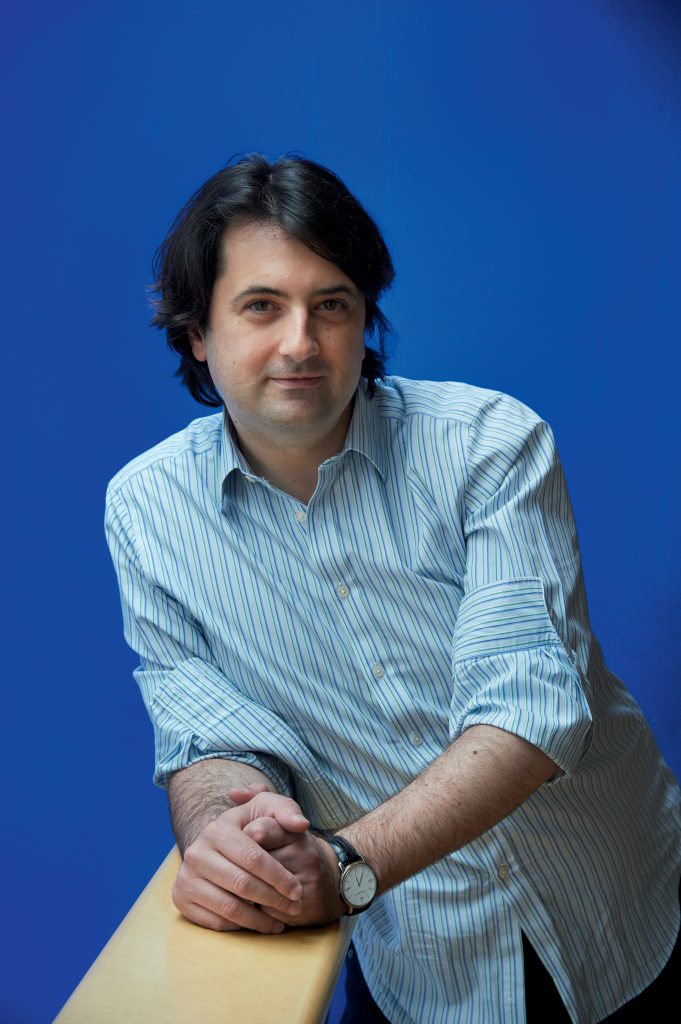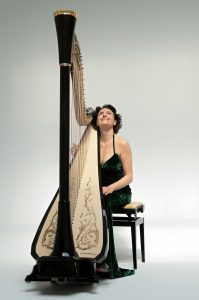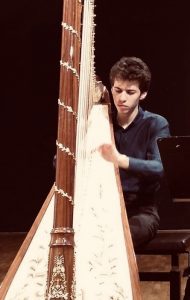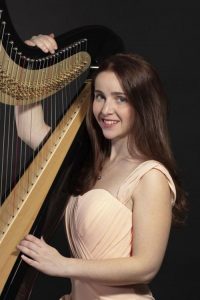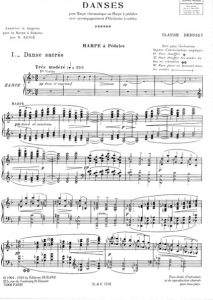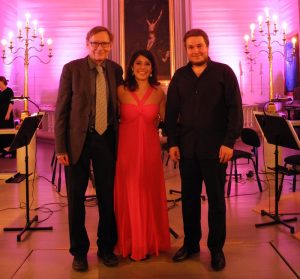Camac Blog
Talking with Bruno Mantovani
Latest
January 25, 2020
There is hardly an instrument more grateful for a good new concerto, than the harp. Happily, you’ve another chance to hear Bruno Mantovani’s extraordinary Danse libre (2017), for harp and chamber orchestra, on January 28th. Marcel Cara will be performing it with the Orchestre de chambre de Paris, at the Théâtre du Châtelet in Paris and with Mantovani himself conducting.
The same orchestra commissioned the concerto. It was premiered by Isabelle Moretti as the soloist, and she re-performed it twice with the Orchestre de Chambre de Lausanne, the following year. She and Mantovani also performed it in South America, with the Simon Bolivar Orchestra in Caracas, and also with young musicians in São Paulo. Danse libre is not Mantovani’s only work for harp. In fact, it’s the most recent, following the solo Tocar (2007), and the Quintette pour Berthold Brecht of the same year. All three surprise the listener, in different ways.
Bruno Mantovani, director of the Paris Conservatoire from 2010 to 2019, is one of France’s best-known contemporary composers. We interviewed him about his works for harp.
M. Mantovani, you describe Tocar as “turning the image of the harp on its head”. How do you do this?
The harp’s problem is that it is relentlessly perceived as agreable. The shimmering, gentle sonority is almost dangerous, because it can enclose and limit the instrument in the minds of composers and audiences. It’s also usually orchestrated as an accompaniment. But it has always been obvious to me that the harp has enormous potential to surprise. I should stress that I never write against the instrument, that’s not the same thing. It’s possible to bring out a different register, one that hasn’t been heard before, but which is nevertheless natural for the instrument, belongs to the instrument.
The title of Tocar is in itself a different register, as justified and present as those we are already used to. English, French, German, all these languages speak of ‘playing’ an instrument – jouer, spielen. If one of those languages is your native one, that’s how you think of it. However, the Italians ‘sound’, suonare the harp, and the Spanish tocar, they ‘touch’ it. Language is an expression not only of direct, but also of cultural meaning, and this simple example reveals different attitudes to an instrument. For me, tocar carries a sense of improvisation: the idea of touching an instrument, and seeing what happens next.
I wrote Tocar shortly after Streets, a chamber piece for the Ensemble Intercontemporain and Pierre Boulez (2006). This has a prominent and also startling harp part. The instrument occupies two extremes: the murmuring tremolo at the start, and a big solo of great virtuosity at the end – quasi an electric guitar riff. I wanted to develop this virtuosity in Tocar, because it is through virtuosity that a new, and genuine, side to an instrument reveals itself.
That’s important. Where composers give voices to the harp we have never previously imagined, these make a huge impact when it’s also clear that these voices completely belong to the harp. Britten is another composer that did this, or also Harrison Birtwistle, in a very different way. It’s as if the music has always been inside the harp, and it was just waiting for somebody to bring it out.
But it’s one thing to recognise this, and quite another to do it. As a composer, how do you define and identify virtuosity on the harp?
Probably the biggest challenge for composers is the harp’s pedal system. Being not totally chromatic, young composers experience a lot of interdictions, they learn what they cannot do rather than what they can. It’s important not to conflate the technical realities of the mechanism with the idea you must limit yourself. I think playing virtuoso – on any instrument – means performing against your habitual reflexes, your learned traditions. Every virtuoso has to be dextrous, but playing fast is not necessarily virtuoso. Many musicians can play fast and fluidly, more today than ever before, and plenty played like that before you, as well. The virtuoso has to create something that surprises the listener, amazes the listener. The transcendental quality of a virtuoso performance is born of this quality. You don’t transcend anything by doing what’s already come before many times.
In your harp works, you combine what is striking, because it is new, with studied reference to music that has come before; your own previous compositions, and the works, also across other disciplines, of others. Tocar came after Streets; Danse libre is written in relation to the Debussy Dances. Your Quintette pour Berthold Brecht (2007) is an extension of stage music you wrote for Brecht’s A Man’s a Man. What relationship is there between your scores, and their related sources?
I’m interested in the potential of a related text, and how I can bring this out. Because I’m writing something new, thus expressing potential that hasn’t been expressed before, I destabilize the source and the perceptions around it. Danse libre is a third dance because chronologically it follows Debussy’s famous two. But musically, it could even be a first dance, preceding them. It anticipates the modal and almost archaic quality of Debussy’s Danse sacrée. It is also a “Danse libre” for the harp in the way it celebrates the instrument as a rhythmic, powerful and savage presence. The connection with Debussy creates another surprise. The audience think they know what they’re going to hear…you must destabilize, to be interesting.
I look for familiar hierarchies to invert, be they among sources or purely musically. If I write a work for violin and piano, I like to include passages where the violin accompanies, and the piano is the soloist. In Streets, the harp swings from a discrete tremolo to a huge solo. The Quintette pour Berthold Brecht contains very expressive passages, but ones which the harp interrupts highly percussively. There’s enormous tension in the intense sequences, but also in the more enigmatic sections. The sparser material is in no way there to relax the discourse.
Debussy said: “Works of art make rules, but rules do not make works of art.” When you upturn our expectations, are you making new rules?
I wouldn’t speak so much of rules, but more of frameworks. Today, we are so free: we can write what we want, we can involve technology, we can travel wherever we want to go. That’s not the same as abandoning all structure. You can’t create a new expectation without an existing one to throw it into relief. You need a balance between what we know, and don’t know. One layer feeds the next, and this is also why I’m so interested in other scores and works of art.
Isabelle Moretti described Danse libre as “a beautiful homage from one of today’s greatest composers, to the greatest of all masters of French music.” Can we still speak of French music, as we can for the era of Debussy and Ravel?
Of course. Today, everything is much more global, and we have far more access to all styles of music. So I would speak more of French “musics”; there is a very big range of contemporary aesthetics, and it’s important to be aware of and think critically about that. But still, English, Italian, French, German…music exists. This is because we are all formed by our native languages, and our cultures shape our ways of thinking. These are also our crucial frameworks.
Bruno Mantovani, thank you for these insights into your music, and your writing for the harp.
“In 2007, Bruno Mantovani wrote a magnificent harp solo piece, full of intensity, called Tocar. From that moment, I dreamed of him writing a concerto for me. I love the way he is “hair-raising”, quite outside the usual clichés, instead engaging with the harp in its percussive, rhythmic register. Bruno totally understood what I wanted; the concerto is called Danse libre (‘Free Dance’), and I am very grateful to him for this homage to freedom – tightly crafted, nonetheless! – that is so important to me. As is often the case in Bruno’s music, the work is rhythmically highly complex. But this is exactly what you need to give the impression of freedom and improvisation. At any rate, this what I feel in and love about the piece.”
– Isabelle Moretti. This is an excerpt from an interview with the Orchestre de chambre de Paris (in French). Read the rest here.
“The immense quality of Bruno Mantovani’s work reveals itself, without a doubt, in the variety of the dynamics, the harmonic richness, the sombre, obsessive character, all in permanent interplay with the resonance of the harp. The first time I heard his preceding works (Tocar, the Quintette pour Bertold Brecht and also the Le Sette Chiese, and the solo piano work Dédale), I was immediately struck by the power he unleashes, and the emotional intensity of the music. As well as being magnificent, it is able constantly to surprise the audience.”
– Marcel Cara
“Bruno Mantovani’s harp pieces are great challenges for the performer, but their impressive virtuosity is amply rewarded by a corresponding result! By means of their very rich writing, they offer an infinite rainbow of colours and timbres, which allows them to be performed again and again. They also never cease to be surprising; they can even transcend the essence of what you thought was your instrument. For example, the trills – very important in Mantovani’s writing – give the impression of sustained sound, like bowed strings. The more rhythmic passages unleash a phenomenal and almost bestial energy, completely deconstructing the sweet or fairy-like image in which the harp is often trapped. Tocar, for example, has entered the canon of the harp’s contemporary repertoire. Its title is apt, because there is no other piece like it.”
– Mélanie Laurent

